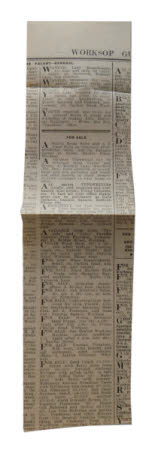Newspaper cutting
Category
Ephemera
Date
12 Oct 1956
Materials
Newspaper
Order this imageCollection
Mr Straw's House, Nottinghamshire
NT 3167079.2.9
Summary
Brown paper envelope containing a series of A. Leslie Armstrong's lecture syllabus 1954, 1956, 1957 & 1958 (record 3167079), a handwritten note, two pages of typed notes held with a pin, six newspaper cuttings, a typed book list and a 'Basildon Bond' note pad of handwritten notes by William Jnr. . The syllabuses (record 3167079) are; 'THE UNIVERSITY OF SHEFFIELD SESSION 1957-58 THE PROGRESS OF MAN IN PREHISTORIC TIMES' 'THE UNIVERSITY OF SHEFFIELD SESSION 1957-58 THE PROGRESS OF MAN IN PREHISTORIC TIMES' 'THE UNIVERSITY OF SHEFFIELD SESSION 1957/58 THE PROGRESS OF MAN IN PREHISTORIC TIMES (PART II)' 'THE UNIVERSITY OF SHEFFIELD SESSION 1957/58 THE PROGRESS OF MAN IN PREHISTORIC TIMES (PART II)' 'THE UNIVERSITY OF SHEFFIELD SESSION 1956-57 THE OLD STONE AGE IN BRITAIN' 'THE UNIVERSITY OF SHEFFIELD SESSION 1956-57 PREHISTORIC BRITAIN' 'THE UNIVERSITY OF SHEFFIELD SESSION 1957-58 THE PROGRESS OF MAN IN PREHISTORIC TIMES' 'THE UNIVERSITY OF SHEFFIELD SESSION 1957-58 THE PROGRESS OF MAN IN PREHISTORIC TIMES' The sixth of six newspaper articles taken from '...KSOP GUARDIAN 12 Oct 1956'. 'IS CRESSWELL CRAGS A PILTDOWN? In a recent edition of the "Derbishire Countryside" Mr. Geoffrey Grigson, in an article, "Caves, Crags and Coal Mines," casts doubt on the authenticity of the Archaeological finds made at Creswell Crags in 1876. he wrote that the excavations made by "a Derbyshire parson and a Man- chester professor 9the Rev. Magins Mello and Professor Sir William Boyd - Dawkins, of Owens College Manchester) was a "minor Piltdown," and went on to say that the tooth, that of a Machairodus, or Sabre-toothed Tiger, and a fragment of bone bearing the engraved drawing of a horses head, both regarded as archaeological treasures, and found in Robin Hood's Cave on July 4th, 1876, were placed there and that neither was a genuine find....'. The Piltdown Man was a paleoanthropological hoax in which bone fragments were presented as the fossilised remains of a previously unknown early human. In 1912 amateur archaeologist Charles Dawson claimed he had discovered the "missing link" between ape and man. After finding a section of a human-like skull in Pleistocene gravel beds near Piltdown, East Sussex, Dawson contacted Arthur Smith Woodward, Keeper of Geology at the Natural History Museum. Dawson and Smith Woodward made further discoveries at the site which they connected to the same individual, including a jawbone, more skull fragments, a set of teeth and primitive tools. Smith Woodward reconstructed the skull fragments and hypothesised that they belonged to a human ancestor from 500,000 years ago. The discovery was announced at a Geological Society meeting and was given the Latin name Eoanthropus dawsoni ("Dawson's dawn-man"). The questionable significance of the assemblage remained the subject of considerable controversy until it was conclusively exposed in 1953 as a forgery. It was found to have consisted of the altered mandible and some teeth of an orang-utan deliberately combined with the cranium of a fully developed, though small-brained, modern human.

